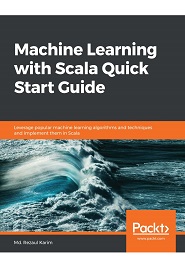
English | 2019 | ISBN: 978-1789345070 | 220 Pages | PDF, EPUB | 55 MB
Supervised and unsupervised machine learning made easy in Scala with this quick-start guide.
Scala is a highly scalable integration of object-oriented nature and functional programming concepts that make it easy to build scalable and complex big data applications. This book is a handy guide for machine learning developers and data scientists who want to develop and train effective machine learning models in Scala.
The book starts with an introduction to machine learning, while covering deep learning and machine learning basics. It then explains how to use Scala-based ML libraries to solve classification and regression problems using linear regression, generalized linear regression, logistic regression, support vector machine, and Naive Bayes algorithms.
It also covers tree-based ensemble techniques for solving both classification and regression problems. Moving ahead, it covers unsupervised learning techniques, such as dimensionality reduction, clustering, and recommender systems. Finally, it provides a brief overview of deep learning using a real-life example in Scala.
What you will learn
- Get acquainted with JVM-based machine learning libraries for Scala such as Spark ML and Deeplearning4j
- Learn RDDs, DataFrame, and Spark SQL for analyzing structured and unstructured data
- Understand supervised and unsupervised learning techniques with best practices and pitfalls
- Learn classification and regression analysis with linear regression, logistic regression, Naive Bayes, support vector machine, and tree-based ensemble techniques
- Learn effective ways of clustering analysis with dimensionality reduction techniques
- Learn recommender systems with collaborative filtering approach
- Delve into deep learning and neural network architectures
Resolve the captcha to access the links!